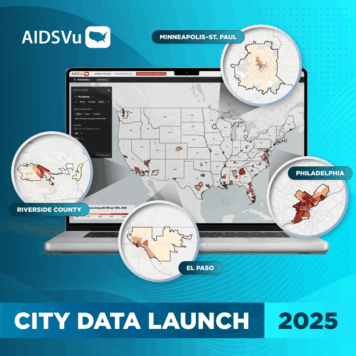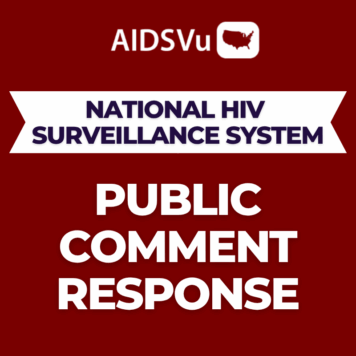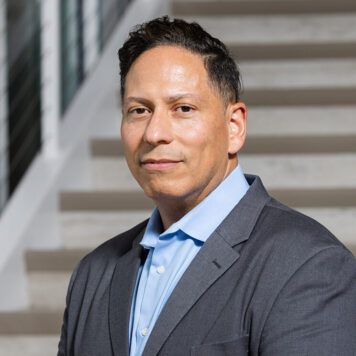Dr. Vincent Guilamo-Ramos, PhD, MPH, LCSW, RN, ANP-BC, PMHNP-BC, FAAN is the Executive Director of The Institute for Policy Solutions and the Leona B. Carpenter Chair in Health Equity and Social Determinants of Health at the Johns Hopkins School of Nursing. Dr. Guilamo-Ramos founded and directs the Center for Latino Adolescent and Family Health (CLAFH), and serves on the board of UnidosUS, the largest Latino civil rights organization in the United States. He is currently working on research to solve the HIV crisis among the U.S. Latino population.
Q: You have a remarkably interdisciplinary career, spanning nursing, social work, public health, and policy. Could you share a bit about your personal and professional journey; what influenced you early on to focus on adolescent and family health in Latino communities, and how that has shaped the work you’re doing now?
For over 25 years, I have worked to end HIV/AIDS. My diverse professional backgrounds have allowed me to view this challenge from different perspectives. Regardless of the approach—whether in my clinical research and practice as a nurse, community work with families as a social worker, analyzing HIV surveillance data and developing efficacious HIV prevention and treatment interventions for Latinos as a public health professional, or examining the barriers Latinos face in accessing HIV services through health policy—evidence of the ongoing Latino HIV crisis was always present. Young Latino MSM, especially those between 25 and 34 years old, have borne the heaviest burden. To illustrate this point: nationwide, annual new HIV infections have decreased by 19 percent since 2010. In contrast, for Latino MSM aged 25-34, annual new infections have increased by 95 percent during the same period. I want to issue a call to action for everyone to share an important set of resources from the Center for Latino Adolescent and Family Health titled “The Latino HIV Crisis Is Now a Cascading Disaster.”
Q: Your new resource, “The Latino HIV Crisis Is Now a Cascading Disaster” at the Center for Latino Adolescent and Family Health (CLAFH) highlights alarming data about HIV among Latinos in the U.S. What were the key findings or trends in this report that most surprised you, and why do you describe the situation as a “cascading disaster”?
When we say that the Latino HIV crisis is now a “cascading disaster,” we mean a chain reaction of harmful events that spreads across interconnected systems, increasing the damage at every step. Unlike simple cause-and-effect relationships, these harmful events grow worse when stress in one system triggers failures in others. Often, the secondary effects are much more severe than the original event. For HIV in U.S. Latino communities, we believe we are witnessing such a dynamic unfold. It’s important to remember that the HIV crisis among Latinos in the U.S. has gotten worse for more than a decade—even as the country as a whole has made major progress in reducing new infections and improving treatment outcomes. Now, the Latino HIV crisis is cascading. Ongoing inequities in our HIV response are driving higher infection rates, more undiagnosed cases, delayed care, and poor viral suppression—creating a destructive cycle that continues to worsen the situation. Proposed cuts to HIV prevention and treatment funding would speed up this downward spiral, making an already serious problem much worse. The longer this cascade continues, the more difficult and costly it will be to stop.
Q: The report emphasizes that Latinos experience widening inequities in testing, prevention (such as PrEP), treatment access and viral suppression. In your view, what are the top structural or systemic barriers that drive these gaps for Latino communities, and how can they be meaningfully addressed?
Failing to prioritize Latinos in HIV prevention, treatment policies, programs, and research is a core issue. Despite the worsening crisis, Latino communities remain pushed aside in the national HIV response. This neglect is compounded by harmful false narratives that diminish Latino contributions to U.S. society and hide their disproportionate burden of the epidemic. This is especially true in today’s political climate, where we might be stopped and questioned on the street because of Spanish-language conversations, our jobs, or our appearance. Challenging and correcting these narratives is crucial to building the social and political support needed to stop the worsening crisis. Latinos also face many specific barriers to accessing HIV services, such as lack of insurance, language obstacles, or past discrimination in healthcare. Furthermore, Latinos are disproportionately affected by harmful social and structural issues, including anti-immigrant policies, unstable housing, food insecurity, and overrepresentation in jobs with low wages and few health benefits—adding more obstacles to HIV prevention and care. This cascade of problems means there are no easy solutions to fix Latino HIV disparities. A coordinated and comprehensive effort from multiple sectors—government, public health agencies, healthcare and social service organizations, pharma, media, grassroots communities, and others—is essential.
Q: Family-based and community-engaged interventions are a hallmark of your research. Given the resource’s emphasis on “invisibility and inaction” in Latino HIV responses, how can families and community networks better be leveraged in prevention and care, especially in culturally responsive ways?
We must give the individuals, families, and communities directly impacted by the Latino HIV cascading disaster a voice and a seat at the table. For too long, Latino voices and leadership have been missing from the decision-making process regarding how we design the HIV response in U.S. communities and from the workforce that implements it at the local level. We need strong Latino representation at all levels, including among elected officials, public health leaders, healthcare organizations, and in the health workforce, media, and more. We know that many of these institutions and organizations work more effectively when they reflect the communities they serve.
Q: The resource also points to the risk of policy and funding shifts eroding hard-won gains in HIV among Latinos. As the field moves forward, what policy changes or investments do you consider essential to reverse the trajectory for Latino HIV outcomes?
In light of recent federal policy changes, including funding cuts for Latino-serving health and community-based organizations and research initiatives, we need a response rooted in societal collective action. The public and private sectors must do more. This includes government, pharmaceutical companies, national HIV organizations, research institutions, and Latino-serving nonprofits working together to address the failure. By investing in Latino-focused prevention, treatment, and community programs, the private and non-profit sectors can play a crucial role in ending this crisis. Key priorities include:
Increase visibility. Take every chance to inform others about the Latino cascading disaster and the urgent need for action—because invisibility leads to inaction.
Confront bias. Challenge damaging misconceptions by rewriting the narrative: Latinos are essential to the country’s health and future, and the Latino HIV crisis must no longer be overlooked.
Strengthen the response by increasing investment in Latino-focused HIV services—expanding culturally tailored, community-engaged campaigns and outreach programs that enhance prevention, testing, and treatment.
Protect and expand data collection. Safeguard the integrity and availability of public health data that help identify problems and guide solutions, so we can invest in evidence-based, Latino-focused HIV research and demonstration projects that ensure prevention and treatment programs truly meet community needs.
Address SDOH. Tackle harmful social determinants of health—such as anti-immigrant sentiment, racism, poverty, housing insecurity, and discrimination—and integrate clinical and social care to enhance prevention and treatment outcomes.
Q: Looking ahead, what are the next steps for CLAFH and your broader work through the Institute for Policy Solutions at Johns Hopkins School of Nursing in terms of this crisis? Are there new initiatives or partnerships you’re pursuing to translate this resource’s findings into on-the-ground impact?
HIV is one among many health inequities that weaken our health system and deepen divisions across our nation. Unlike many other complex public health crises, the HIV inequities we face—including the cascading disaster in Latino communities—can be addressed with tools we already possess. What’s lacking is not knowledge or capacity, but the societal and political will to take action.
Across the country, there is increasing recognition that eliminating health inequities is both achievable and urgent. Recent public opinion polls show that 93% of Americans support the goal of health equity, and 71% believe that achieving health equity should be a top or high priority for the U.S., indicating a readiness for transformative change. What remains is turning this support into action—pressing leaders to prioritize ending health inequities by investing in communities that have long been left behind. To accomplish this, we are launching a national campaign, Bridging Our Divide: Eliminating Health Inequities for a Healthier Nation, on December 17, 2025. During the campaign launch, we will share results from our own public opinion research through the IPS National Health Inequities Survey—a pioneering annual survey that measures how Americans across diverse groups view and experience health inequities. By harnessing public opinion, promoting evidence-based solutions, involving leaders from various sectors, and challenging the systems that sustain inequities, the campaign demonstrates that eliminating health disparities is a smart strategy for fixing our broken health system. I want to extend a warm invitation to all readers to attend the free December 17 launch event in Washington DC, either in person or virtually, and please spread the word about this important opportunity to help bridging our divide.




